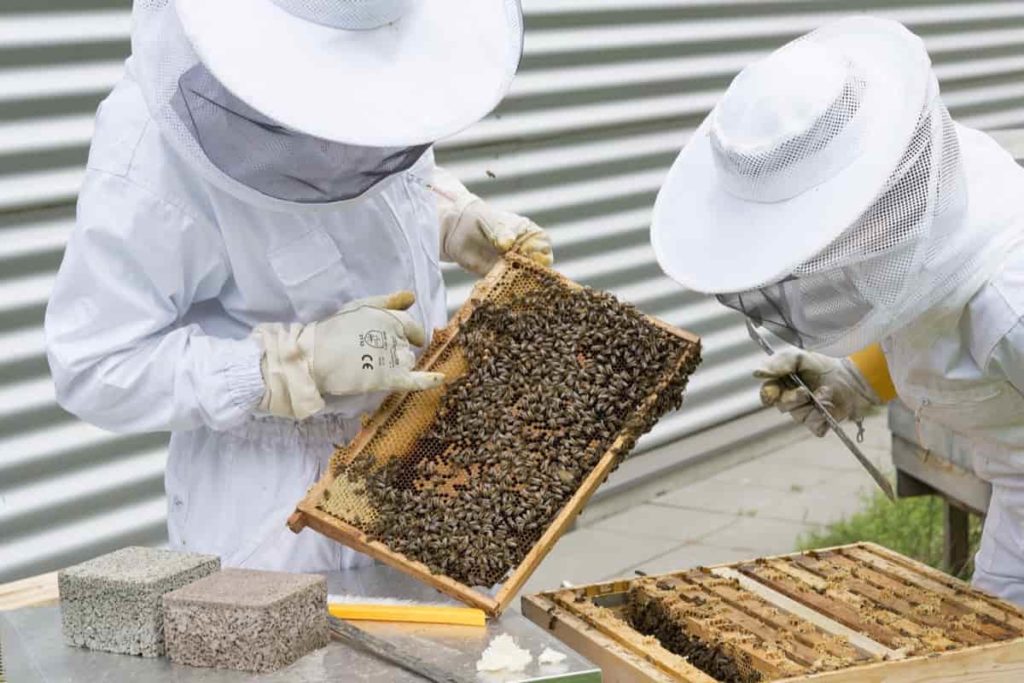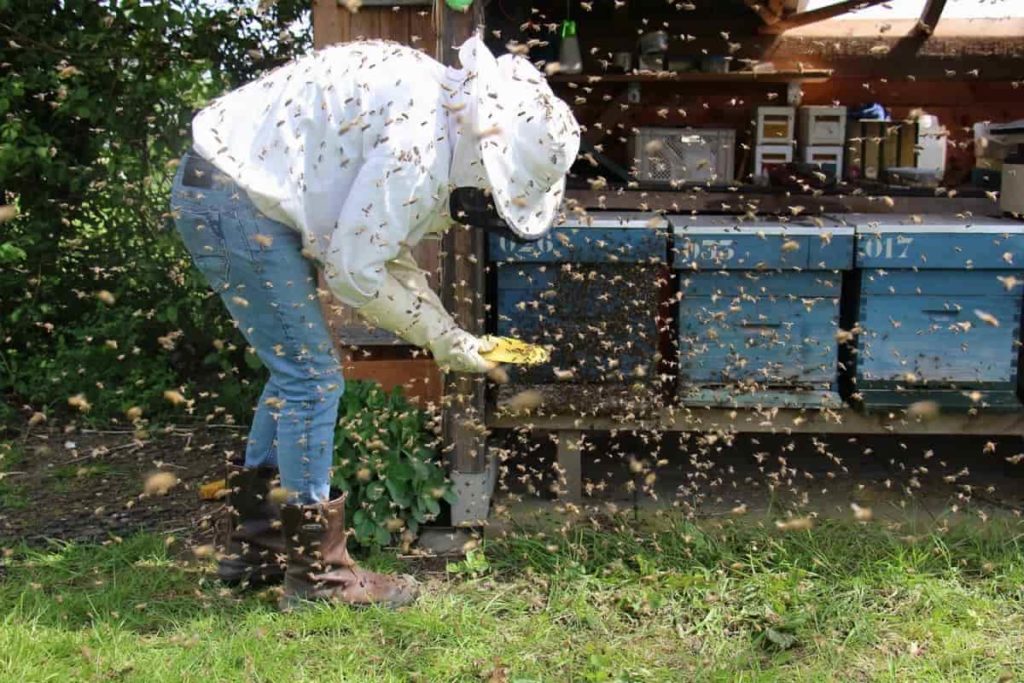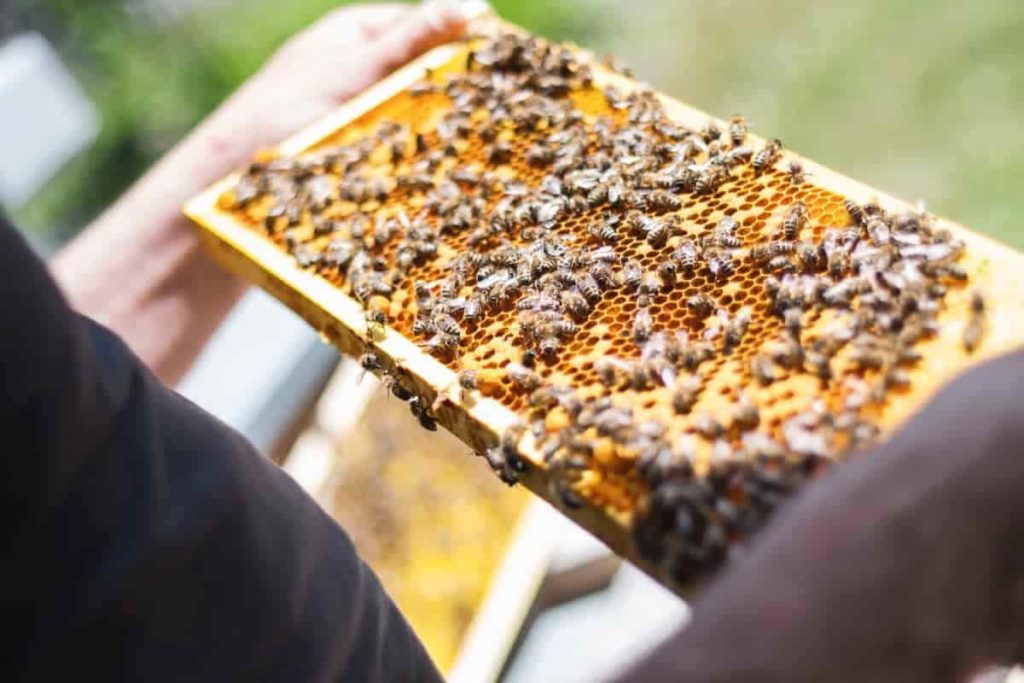The practice of raising and managing bees is known as Apiculture. The apiarist is another term for a beekeeper, while the Apiary refers to the full colony setup. Beekeeping has been more popular in recent years, and raw honey, royal jelly, and bee wax are in high demand. Take the time to study how to establish a honey bee farm before introducing bees since it requires some special considerations. Having ready before the bees arrive will help you succeed, just as it will with bringing any other animal to the farm.

Water, sun, and a solid hive are all necessities for bees, and they may also require nourishment at certain times of the year. If possible, place the hive leaning against a tree line or fence to keep it safe. Every day, bees will fly a considerable distance to find sufficient pollen. Pollen is produced by grasses, shrubs, plants, flowers, and trees, which is utilized by bees to maintain the hive. You don’t need a thriving flower garden, but a diverse garden can provide adequate food for the bees.
How to Start Beekeeping from Scratch in the Backyard at Home
Study about the bees and their hives
There are many books on beekeeping available, and knowing everything you can about these charming tiny creatures can help you get your hives off to a good start. Read all you can so when your bees come, you’ll be prepared and know how to care for them. Let’s learn about how a beehive works before you dive in and start purchasing materials. Bees build nests in the wild, fly to flowers to collect nectar, and then return the nectar to the beehive, where it starts turning into honey.
Choosing the location
There are four things that bees require. First and foremost, they require sunlight or, if the weather is hot, midday shade. Second, they need to be able to get fresh water close to the hive. Use saucers with stones for it for helping bees land and refill them every day with water. A modest bubble fountain might also be appropriate. Third, the hive must be shielded from the wind, which can blow rain into the hive, making it more difficult for the bees to keep it warm. Finally, bees require solitude.
Place the hives away from high-traffic areas, such as playgrounds, swimming pools, and pet areas. Give each hive ample room—ideally, 50 feet away from high-traffic areas, but if space is restricted, place the hive behind a tall fence or hedge. As a result, their flight route will be forced overhead, avoiding interaction with humans and pets. Bees and people will both be pleased if they are hidden from view. Even if keeping bees is permitted where you live, tolerating your next-door neighbor’s unwavering hate or suspicion is typically not worth it.
In case you miss this: Small Home Gardening Design, Ideas, Tips, Techniques

Locate another suitable area if this is the case. Consider taking a few additional measures if your family and your neighbors are okay with it. It’s a good idea to keep things out of sight and out of mind. Colonies don’t have to be white to be effective; they can be brown, green, natural, or speckled. Mischievous children’s prying eyes can be avoided if they can’t notice your bees. Hedge plants can be used as a screen, or they can be hidden behind a place like garages. This makes your bees fly above the human height and while coming back they come from up above the screen which makes it an interesting close encounter.
Equipment needed for beekeeping
Wooden boxes
This box is the beehive itself once you start beekeeping. Start with two hives so you can study and compare them and see what works and what doesn’t. Beekeepers often purchase one because it’s pricey, and they don’t know what they’re looking at, and they dont have any other box to compare it with.
Protective veil and gloves
Inexperienced beekeepers should prevent stings at all costs. You don’t want to get stung and become distracted, causing you to damage the frame by dropping them on the ground.
Smoker
While working in the hive, this will aid in quiet and diverting the bees.
Hive tool
This must-have, which looks like an extended paint scraper, helps you to effortlessly enter the hive and shift frames around.
Bees
If you’re ordering bees, make sure you buy enough bees for two colonies.
What are the types of beehives?
Langstroth
This is a familiar sight in many gardens. The Langstroth is made up of supers, which are wooden boxes placed on top of one another. They are supported by a foundation board and are covered with a cap or lid. Inside the super, the bees build their honeycomb and load the chambers with honey using waxed frameworks that hang vertically.
Top bar
The Top Bar hive resembles a trough used to feed animals. The bees create their comb by dragging it down from the top of the hive’s wooden bar.
Warre
It has been considered to be a hybrid of a hollowed-out tree and a top-bar hive. The Warre Hives are a fraction of the size of the Top Bar and Langstroth counterparts.
Skep
Beekeepers used a skep to maintain their bees for a long time. Because it is difficult to collect the honey out from skep and because this style of the hive is difficult to maintain and can become unclean, it is no longer employed. Skeps may be used as vintage decorative addition equipment, even if they are no longer in service. Use cinder blocks or a table to lift the hive above ground level, regardless of the type of beehive you begin with.
In case you miss this: Urban Gardening for Beginners, Tips, and Ideas

Preparing the location
It is necessary that hives should face south, and they should be maintained off the ground to avoid wetness and rodents. Prepare a cement pad to make maintenance easier after removing the bush and leveling the area. Keep your hives above the ground as much as possible. Use a hive stand that is simple to manufacture and affordable.
The hives are raised approximately 18 inches from the floor to safeguard them from creatures, and there is enough space among each hive to install the coverings and honey supers later in the season while inspecting the hives. Consider putting anything on the ground near your hives, such as bark mulch, old carpeting, gravel, or stones, to keep the mud at bay.
How to get your bees?
To that end, there are two common methods for populating your hives. The most popular way is a package, which consists of a little screen box containing roughly 10,000 loose bees. The queen, which is usually unrelated to the other bees, is kept apart in a cage.
You may, on the other hand, purchase a nucleus colony, which is a little colony. Each one already has an active laying queen and five comb frames. Nuc colonies are roughly $50-$75 more expensive than packages, but they’re approximately six weeks ahead in terms of development.
Feeding the bees
Young colonies have a lot of work ahead of them, including storing pollen and nectar, sealing any gaps in the boxes, and caring for the queen and her young offspring. Some people feed them “nectar” to make the process easy for bees. Here’s how you do it: Fill the quart jars with an equal mixture of granulated sugar and water. Invert the jars into the perforations and cover them with the feeder lids.
The lids should be just damp, not dripping. The bees will sip from the lids as much as they require. Bees, on the other hand, will find nutrients in flowers if your garden has enough flowers. Furthermore, sugar water produces insipid honey and should not be used if it is not required. The time to place your honeybees in their hives is in the spring when flowering flowers provide a food source.
Checking the hives inside and out
A lot of beekeeping is just observation and reaction. If you’re a beginner beekeeper, examine the hive once a week for a few months to learn the roots. Adjust your schedule to every two weeks once you’re comfortable. Make sure the hive is clean and clear of bee excrement on the outside, the landing board is litter-free, and check if the hive is ants-free. Open the hives and look for larvae and eggs in the frames. You’ll witness a lot of larvae in different phases of development if the queen is healthy. Consult a specialist if you don’t observe any signs of a healthy queen.
In case you miss this: Aquaponic Garden Setup, Design, Techniques, Ideas

A smart place to start is your local beekeeping guild. Finally, the hive’s health will improve if you examine it less frequently. To keep the bees quiet when opening and properly inspecting the hives, it’s necessary to smoke. The bees are stressed as a result of this, and it takes them roughly a day to heal. As you gain experience, you’ll see that you don’t need to pull many frames to figure out what’s going on inside. And simply watching the bees as they arrive and depart from the hive will teach you a lot.
Checking for pests and diseases
The most common pest encountered in beehives is Varroa mites. They have the potential to weaken and destroy the hive if left unchecked. The small hive beetle and the wax moth are two other pests to watch out for. American and European foulbrood are two diseases you should be aware of. The difference between a healthy hive and a dying hive is typically determined by early intervention.
How to collect honey from bees?
The bees usually build up their hive during the first year, and if they overwinter properly, you may start collecting in the late spring or early summer of the second year. Use the following procedure if you don’t have access to a professional extractor.
Crush and cut
Cut the honey, wax and all, off the foundation into a bowl with the bench scraper, resting the frame on a wooden spoon laid over the basin like a bridge. The honey and wax in the basin should be then crushed with a wooden spoon.
Straining and settling
Pour the wax and honey slurry into a plastic bucket through the double layer of cheesecloth and a stainless-steel strainer. After then, let it drain and settle for a few days.
In case you miss this: Guide to Growing Red Banana in Home Garden: Planting and Care

Bottling
Cover the floor with newspapers and prepared our jars. Then, to release the honey into each jar, loosen the honey gate, which is the stopper at the bottom of the bucket. You may get about 12 pounds, 10 ounces of honey from four full frames of honeycomb. Rinse the excess wax and place it in the freezer. After that, use a solar wax melter to render the wax and use it for crafts like lip balm.
Expand your hive
Begin with a single body-brood box from a deep beehive. Top it up with a second brood box once the bees have loaded it with 7 or 8 frames of bees and brood. Allow the bees to start laying eggs in the second brood box as well. When the second brood box is full (7 or 8 frames of bees), add the queen excluder and the honey super.
Frequently asked question about backyard beekeeping (FAQ)
How much does it cost to start a beehive?
It’s a costly pastime, or a costly trade if you decide to turn it into a company. I believe that this has surprised some individuals. A beehive arrangement will cost around $150 or more. Then there’s the expense of the bees, which may range from $150 to $300 depending on where you live. If you ever have to change your queen, it can cost anywhere from $20 to $50, but you’ll almost always have to pay for overnight shipping, which can be rather costly. The bee costumes alone cost between $100 and $200, plus you’ll need extra equipment.
Is beekeeping time-consuming?
The majority of the time is spent learning. So spending time reading, buying a lot of books, taking classes, investigating what you’re seeing, and just immersing yourself in that information. As a beginner beekeeper, you’ll spend most of your time there until you grasp what you’re doing, which I believe takes around two years for most individuals.
It’s not like caring for a dog, where you have to be on call 24 hours a day, seven days a week. In the spring and summer, you only examine your hives every two to four weeks. A hive check takes approximately an hour. Even if you go on a holiday for a couple of weeks, your hive would still be okay.
In case you miss this: Earning 24 Lakh from Greenhouse Farming – A Success Story

How do you know when to harvest honey?
So, if you’re a beginning beekeeper, the general guideline is to avoid harvesting in the first year. That’s what everyone says, and it’s because your colony is so new. They haven’t had much time to establish themselves. When the honey is ripe, it will be topped over, so you can tell it’s ready by looking at the combs. When it’s 70% capped, you may take that section of the comb.
Sometimes you’ll find tiny regions of honey on the same piece of comb in the brood nest where the kids are, and beekeepers shouldn’t take that honey. You should wait till you have a whole piece of honeycomb with no young bees on it. That’s what you’d get out of it.
- Gardening Techniques in Planting Vegetables
- Where to Place Indoor Plants in Your Home
- How to Grow Tomatoes Organically at Home: A Comprehensive Guide
- Organic Gardening on a Budget: Low-Cost Methods and Materials
- Gongura Seed Germination and Planting Methods
- Cabbage Seed Germination and Selection
- Broccoli Seed Germination and Selection
- Asparagus Seed Germination and Variety Selection
- Seasonal Flower Gardening: Best Practices for Spring, Summer, Fall, and Winter
- How to Grow Hibiscus from Flower
- Plantation Ideas for Home Decoration: A Beginners Guide
- Flower Garden Designs and Layouts for Beginners
- Planting and Spacing Techniques in Papaya: A Beginner’s Guide
- Growing Gold: Essential Techniques for Planting Pineapples
- How to Make Kalanchoe Plant Bushy: Home Remedies and Solutions
- 11 Reasons Why Your Gardenia is Not Blooming: Home Remedies and Solutions
- Eco Elegance: The Guide to Designing a Drought-Tolerant Landscape
- Gardening on a Slope: Strategies for Hillside Landscaping
- Nourish and Flourish: Top Organic Mulches for Thriving House Plants
- Everything You Want to Know about Indian Mogra Flower: Discover Uses and Growing
- Green Thumb Success: Expert Tips for Cultivating Greenhouse Pumpkins All Year Round
- Maximize Growth & Flavor: The Ultimate Guide to Companion Planting in Herb Gardens
- How to Control Rhododendron Problems Naturally: Home Remedies and Organic Ways to Fix Them
- Natural Magic: The Remarkable Benefits of Cinnamon for Plants
- Best Steps to Revive Dying Tulip with Natural and Organic Treatment
- 10 Reasons Why Your Angel Trumpet is Not Blooming: Remedies and Treatment
- How to Fix Periwinkle Leaf and Flower-Related Problems: Natural Remedies and Solutions
- How to Fix Zinnias Leaf and Flower Problems: Discover Natural and Home Remedies
- Organic Steps to Induce Lemon Tree Flowers: A Comprehensive Guide
- Bloom Booster: Crafting the Perfect Homemade Bougainvillea Fertilizer
- Optimizing Growth: A Guide to Applying NPK Fertilizer for Potted Plants
- 10 Best Homemade Fertilizers for Rubber Plant: DIY Recipes and Application Method
- How to Boost Female Pumpkin Flowers: Effective Steps for More Flowers and High Yields
- Transform Your Indoor Garden: Top Benefits of Pink Salt for Houseplants
- 10 Best Homemade Fertilizers for Peacock Plants (Calathea): Easy DIY Guide
- Unlock Blooms: 9 Reasons Why Your Potted Chrysanthemum is Not Blooming
Excellent information for Beginners…
This is great and well detailed.
Is there a course to attend?
For how long?
I a very interested.
Thanks